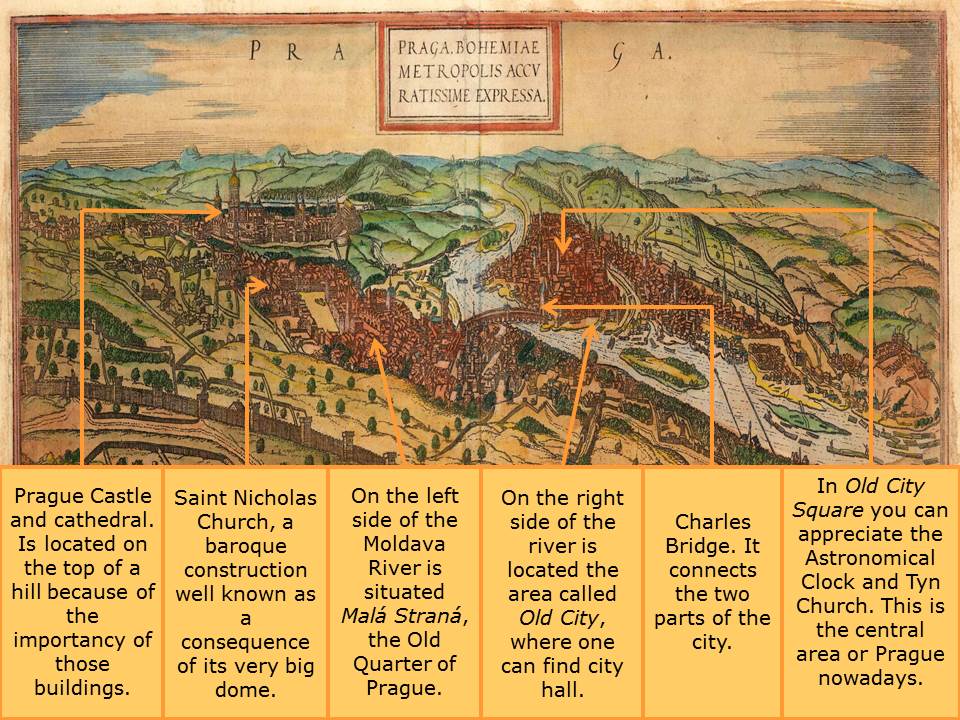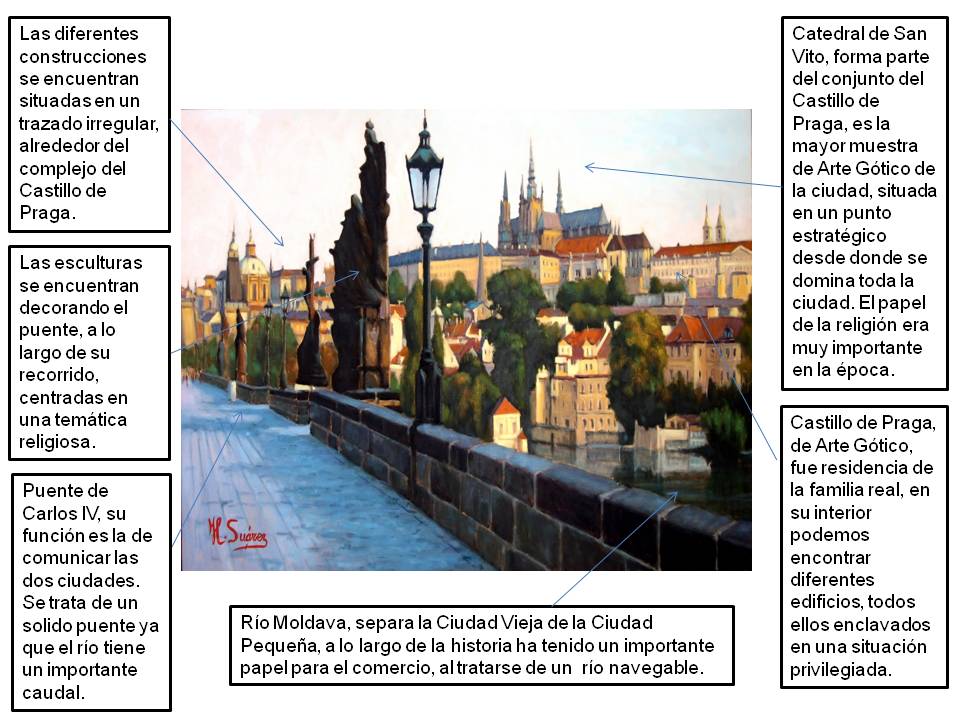PRAGUE (Yuriy Shechuck, 1990)
This picture represents the city of Prague. It was created by Yuriy Shechuck, whose oeuvre has been developed between the last quarter of the 20th century till the current days of 21st century, that is to say that we are on speaking terms of recent art.
Prague is the capital of the central eastern European country of Czech Republic and the most important city of Bohemia Region, nestling just in its centre. 1.3 million inhabitant live within its 492 km2 area. The city is influenced by two types of climates: oceanic climate and humid continental climate. It is also influenced by the different heights that Prague has, being the highest peak 400 meters high and the lowest 177 meters. What’s more, in 1992 the historic centre of Prague became UNESCO World Heritage Site.
Although the area of Prague has been inhabited since around year 200 BC first by Celts, Prague did not gain relevance up till the 10th century when it became the dwell of the Dukes, later the Kings, of Bohemia. From 1346 onwards Prague was already considered as the most important city of the region and its economic development was unstoppable, even though the city was hit by plagues and wars. The importance of Prague comes from its location on the map, strategically settled in the centre of Europe, which made Prague an important trade point in the continent. Since 14th century, Prague, in terms of political, economic and cultural issues, has been the main city in the country.
From the Middle Ages, Prague owns an irregular urban layout conditioned by the topography and delimitated by both riverbeds of Vltava river. It is remarkable that Prague is very fragmented. Within the municipality boundaries, the city centre is the most constant, from there; it is seemed that little settlements lie around it, separated by large forests.
The Vltaba river splits the city in two parts, Stare Mesto and Malá Strana. This painting portrays the core area of Prague, Stare Mesto (Old Town). During the 11th century the inhabitants that lived around the the Castle began to expand to the East of river Vltava by building up this neighbourhood. Nowadays Stare Mesto hosts the highest affluence of tourists.
Squares, houses and churches constitute the major medieval area of Prague. In this zone it is set up Old Town Square being a crucial point of public life in the Middle Ages where some buildings such as Tyn Church and Old Town hall overshadow. Tyn Church was built in the XIV century. It is an incredible Gothic style church which has two sharps towers pointing at the skies of Prague. Mixed among houses and narrow alleys of the city centre, this church is the major Gothic symbol of Prague with a large history amid its walls. The church has 52-metres long and 28-metres width though the most important details are the two 80-metres high towers.
The Old Town Hall of the Old Town Square is one of the main attractions situated in Prague due to the location on one of its sides of the Astronomical Clock of Prague. This building, used as Town Hall up till the end of XVIII century, overshadows by its impressive 60 metres high Gothic tower where offers us an incredible view of all city centre. The Astronomical Clock of Prague is the most famous medieval clock around the world built in 1490.
Charles Bridge, the most famous monument in Prague, communicates Old Town with Malá Strana. The Powder Tower is a black Gothic construction just situated at the entry of Stare Mesto. Also, it can be found the Municipal House, considered the most prominent Art Nouveau buildings in Prague and Clementium that is the second biggest architectural complex in Prague. We also find Saint Nicholas Church of Mala Strana, considered as the most beautiful Baroque construction of Prague. It started to be built in 1673 by Jesuit order, being the school and the parochial building the first to be finished. Even though in 1752 the works had ended, masses began to be officiated in 1711. In the access square to the Church there is the Plague Column with the Saint Trinity Statue. It was built by Alliprandi in 1752.
Apart from the old town we find others significant neighbourhoods such as Hradcany area, Nove Mesto and the Jewish neighbourhood.
Several architectural styles are throughout the city of Prague. Around 13th century stone buildings began to be constructed and one century afterwards Gothic style started being the most predominant in the city creating the charming atmosphere of Prague. Baroque is common in the current city. The Renaissance style based on classic aesthetic makes Prague to look different because of the magnificent appearance of some of its buildings. French Classicism has been very influenced by the Czech style. At the beginning of 20th century a new epoch was born best known as Modernism which can be found in some buildings throughout Prague.
As a conclusion, Prague dazzles with its historic and cultural richness even hide in the most little details, which make Prague deserving of being visited if we want to experience a time journey through nearly 8 centuries of History.
Paula Calvo Pinto



